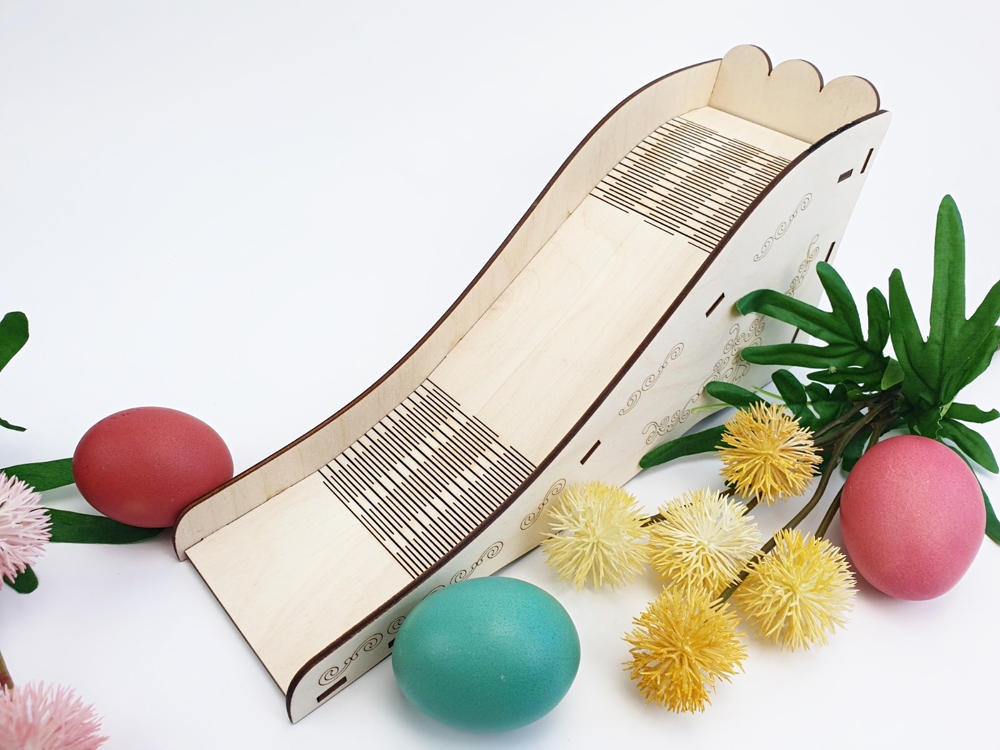
In pagan times the Easter season was celebrated by our forefathers as a rite of spring, the earth‘s reawakening after winter. Of course, once Lithuania became Christian, Easter commemorated the Resurrection of Jesus Christ. As Lent draws to a close, the year‘s first blossoms appear, and preparations begin for Easter celebrations, thoughts turn to cleansing souls and cleaning homesteads, spring chores, plans for Easter feasting and especially “margučiai“ – decorated Easter eggs.
Easter egg decoration varied by region in Lithuania, but natural dyes were used everywhere. A popular species of daisy (chamomile, Matricaria recutita) would produce a yellow-green hue, nettles were used for green, beet broth for reddish brown, and onion skins for golden brown. (See https://ltfai.org under Resources/Instructions for dye recipes and decorating instructions).
Easter eggs in Žemaitija tended to be dark and even black, and they were usually decorated using the wax (batik) technique. In Suvalkija eggs were dyed red and violet, in Dzūkija they liked grayish tones, and in Aukštaitija mostly onion skins were used.
Many of us still play the “strongest egg“ game, where you enclose the egg in your hand with just the tip peeking out between your curled index finger and thumb, and you allow another person to smack your egg with the tip of theirs. If yours breaks, you switch to the other end of the egg, and if that breaks – you lose. (Marble or ceramic eggs are not allowed.) Another Easter tradition was rolling eggs in a special trough. If your egg hit someone else‘s, you win that egg. If not, your egg stays in the playing field.
Lalavimas was a type of singing performed at Easter, originally by groups of men in Dzūkija. They would learn Easter songs, hymns and poems, called lalinkos because the refrain was usually “ei, lalo“ or “vai lalu lalu“. Young bachelors would take their musical instruments and visit their neighbours to bless them with their songs, and receive margučiai for their efforts. They would always be sure to visit the homes of marriageable young ladies.
In Žemaitija young children would visit neighbours and relatives to beg for margučiai. They would have to recite a little rhyme before showing how many eggs they wanted by sticking that many fingers in their mouths. Swinging on swings was a popular pastime at Easter, and swinging as high as you could ensured a good harvest.

Of course the Easter table included not only margučiai, but Velykų boba (similar to panettoni) and a wide array of cheeses and meats. A pig or wild boar head was essential, and every dish was decorated with greenery. An Easter tree was created from a stick with at least 12 wire branches curved around at the ends to hold an Easter egg. The stick and its branches were decorated with coloured paper and paper flowers and set on the table as a centrepiece. This was particularly popular in Aukštaitija. It was believed that margučiai bring health and good luck. The traditional Easter cake, called “Velykų boba“ is widely known in many parts of Europe. In olden days, it was baked in a special tall clay container, which was broken after the boba was baked, and then the cake expanded like a well-rounded older woman…
Here is a traditional recipe for a citrus-flavoured boba, published by the Lithuanian newspaper Kauno diena several years ago. This is a metric recipe, with approximate equivalents:

Velykų “Boba“
-350 g flour (about 3 cups)
-120 ml sour cream (4 oz)
-100 g sugar (3.5 oz)
-100 g butter (3.5 oz)
-4 eggs
-4 teaspoons lemon juice
-1.5 teaspoons baking powder
-1 teaspoon lemon zest
-1 handful raisins
Glaze:
-125 g sugar
-Juice of 1 lemon
Beat eggs with sugar, add melted butter and sour cream. Mix well. Sift flour with baking powder, add lemon zest and raisins which you have soaked in water, and lemon juice. Combine this mixture with the egg batter, and add to a butter-greased pan. Bake for 50 minutes at 180o C (350 oF). Allow the cake to cool. Beat lemon juice with sugar and glaze cake once it is cool.
<<>>
There are many recipes for Boba and many ways of decorating them. Coloured sprinkles on top of the glaze, lemon or orange zests, or flowers in the centre of a cake baked in a ring pan always looks pretty. Here is one more recipe to try. The traditional cylinder shape can be produced by using a tall coffee can to bake in (for the following recipe, 3 one-pound coffee cans were used). The dough can be formed in a figure-eight on a flat baking sheet, using empty cans to keep the loops from closing as they bake.
Lithuanian Babka/Boba/Bulka
-2 pkgs dry yeast
-½ cup warm water (105-115oF)
-2 tablespoons sugar
-1 cup scalded milk
-8 egg yolks
-1 cup sugar
-4 cups flour
-½ cup unsalted butter, melted
-½ cup oil
-1 cup raisins
Preheat oven to 350 oF. Grease the baking pans. In small bowl, dissolve yeast in warm water, stir in sugar and let stand until foamy. In large bowl, beat eggyolks and 1 cup sugar until light. Add yeast mixture. Slowly add flour, alternating with warm milk. Finish kneading by hand (or use dough hooks in mixer). Dough will be sticky. Cover and let rise in a warm place until doubled, about 2 hours. Punch down and add raisins. Divide dough into 3 equal parts and fill the cans about ½ full. Set aside in a warm place and let rise until almost doubled. Bake for 35 to 40 minutes. Remove from oven, allow to cool slightly. Remove from cans, cool completely. Glaze and decorate as desired.
From Treasures of Lithuanian Cooking





























